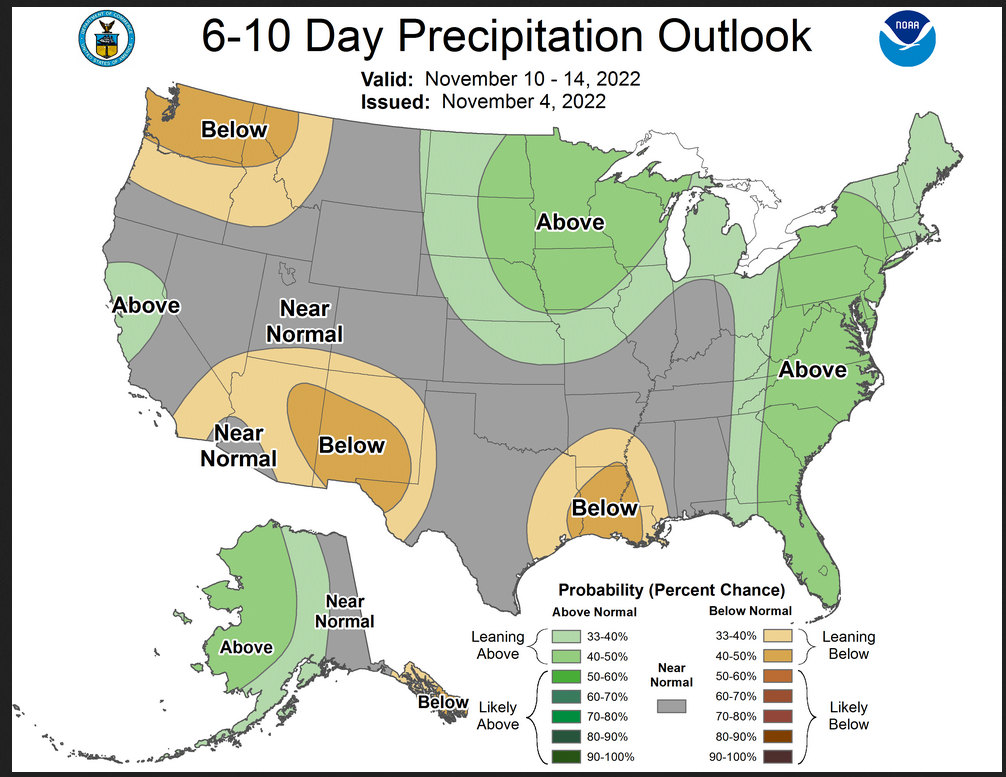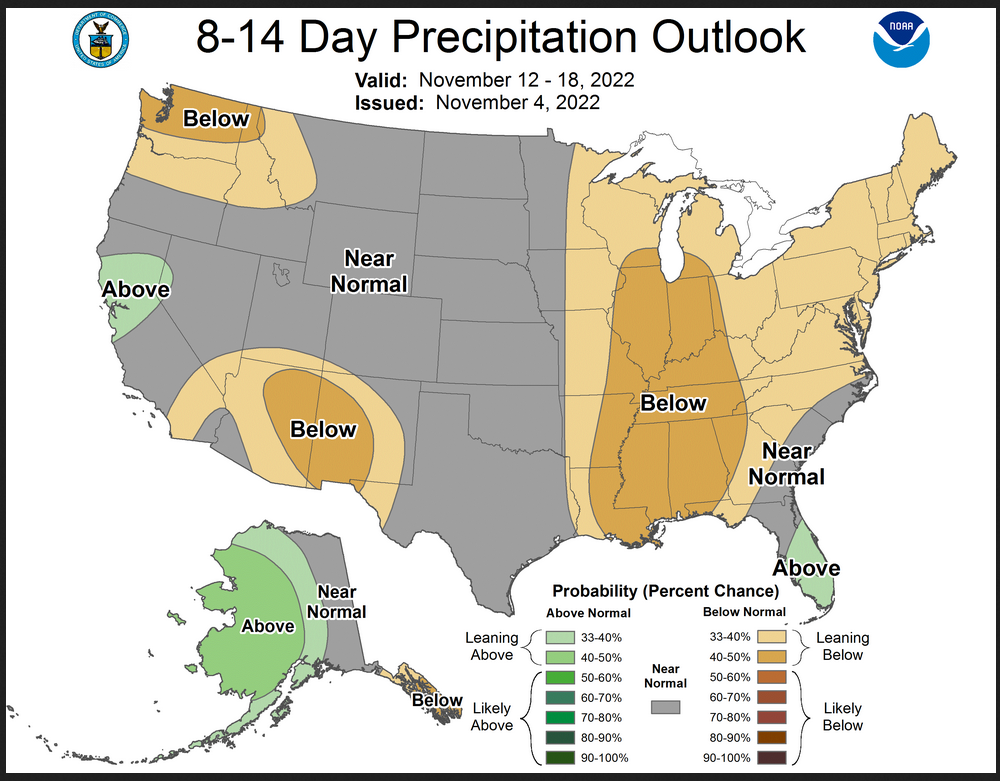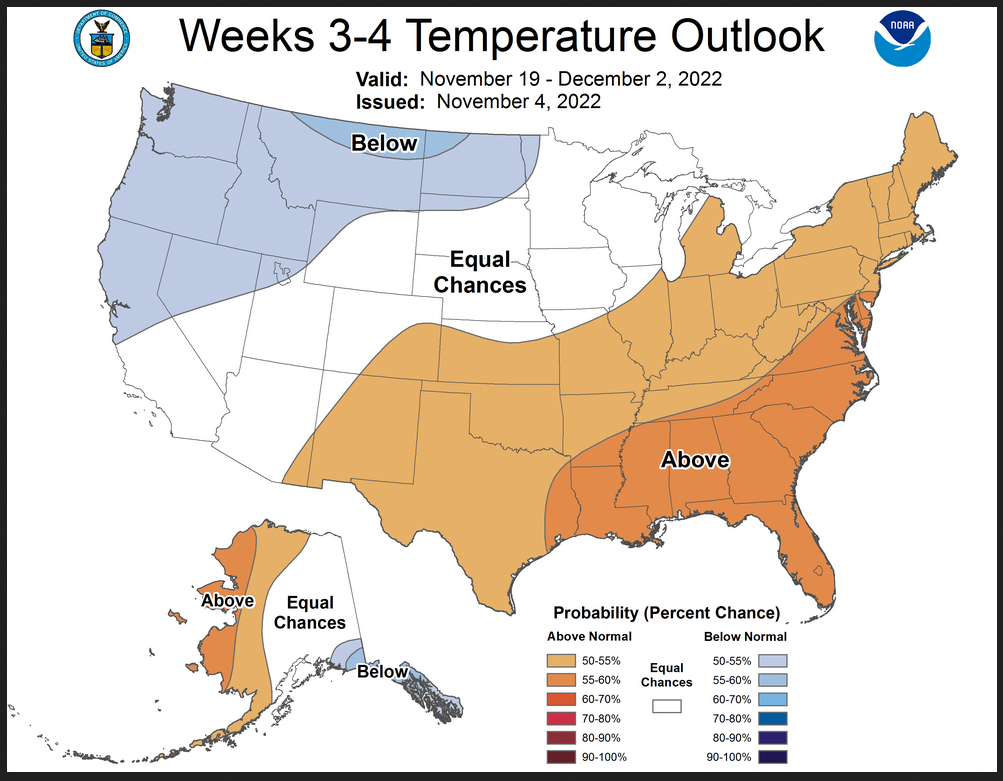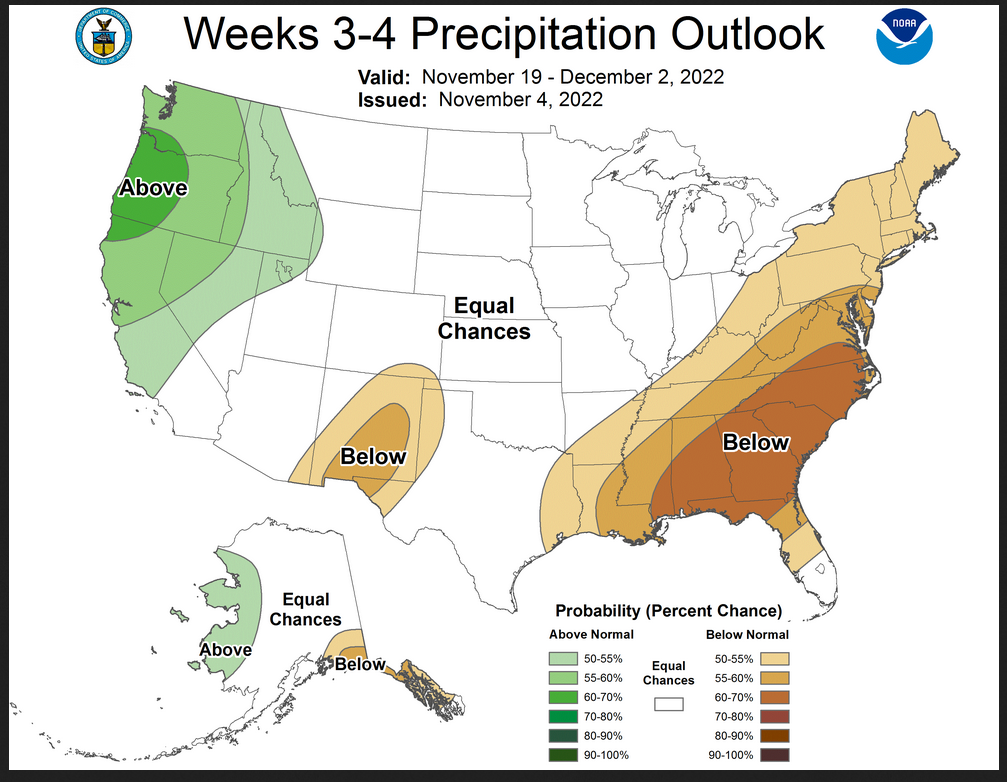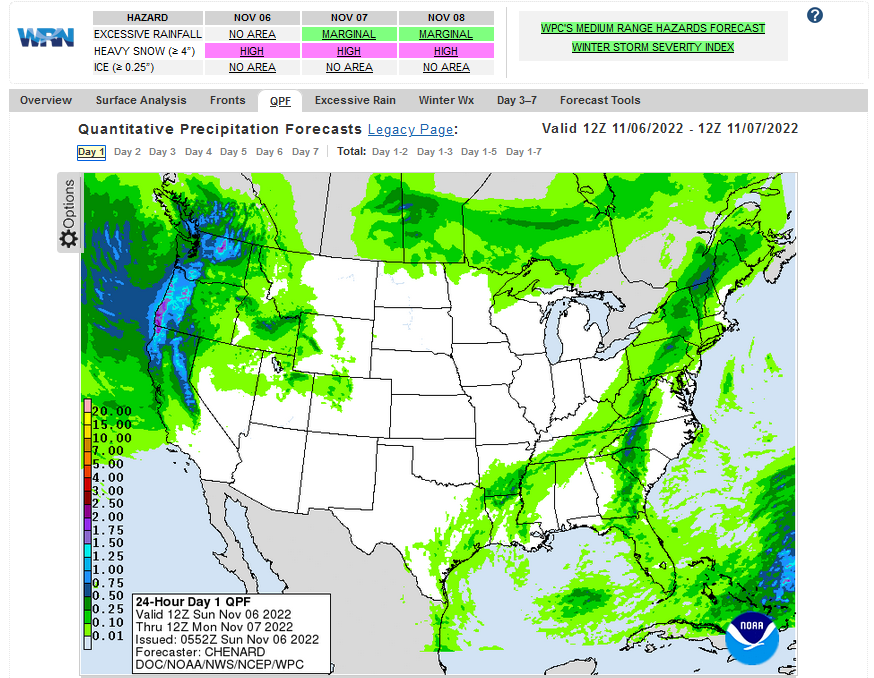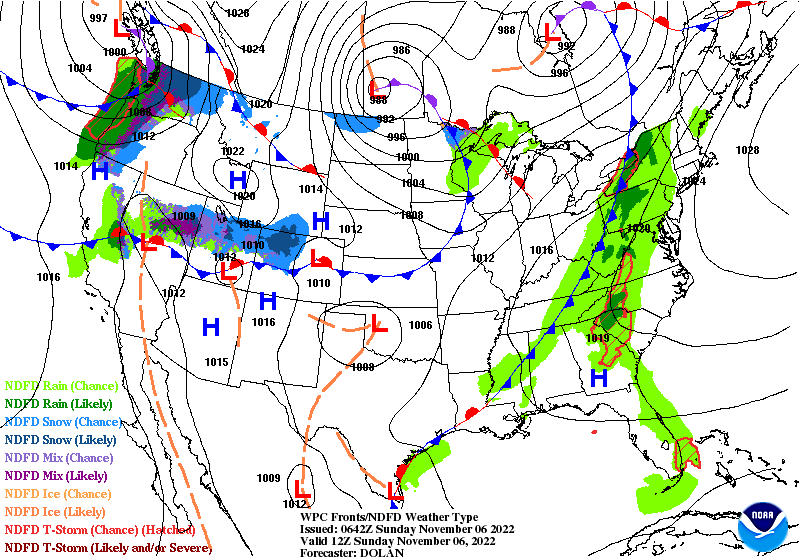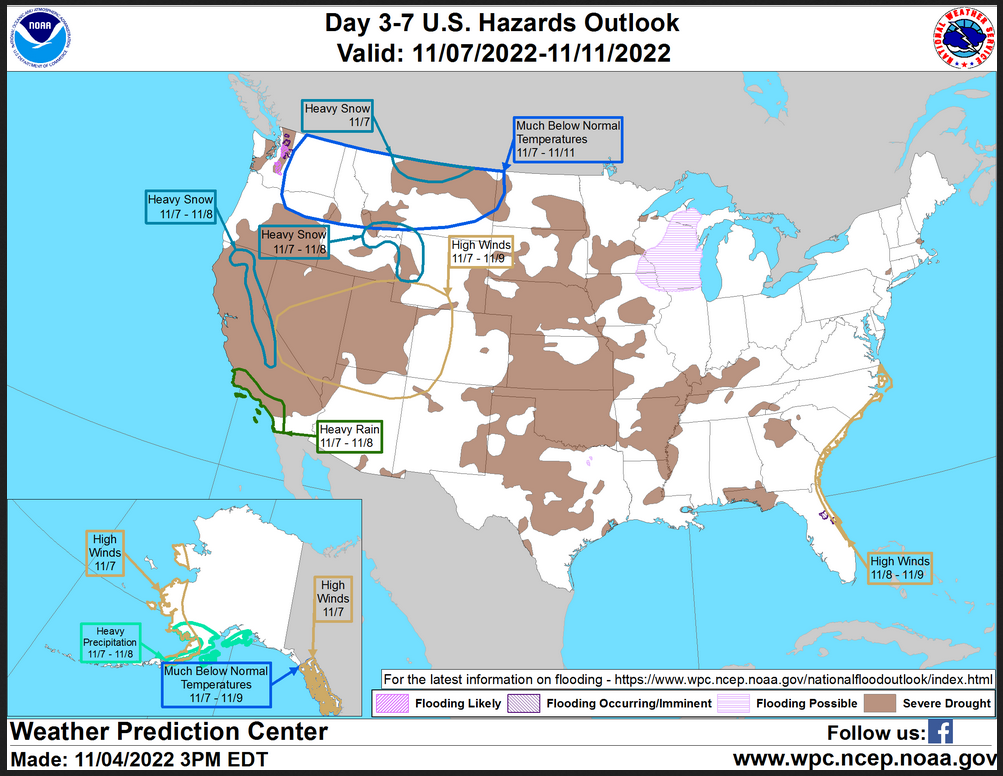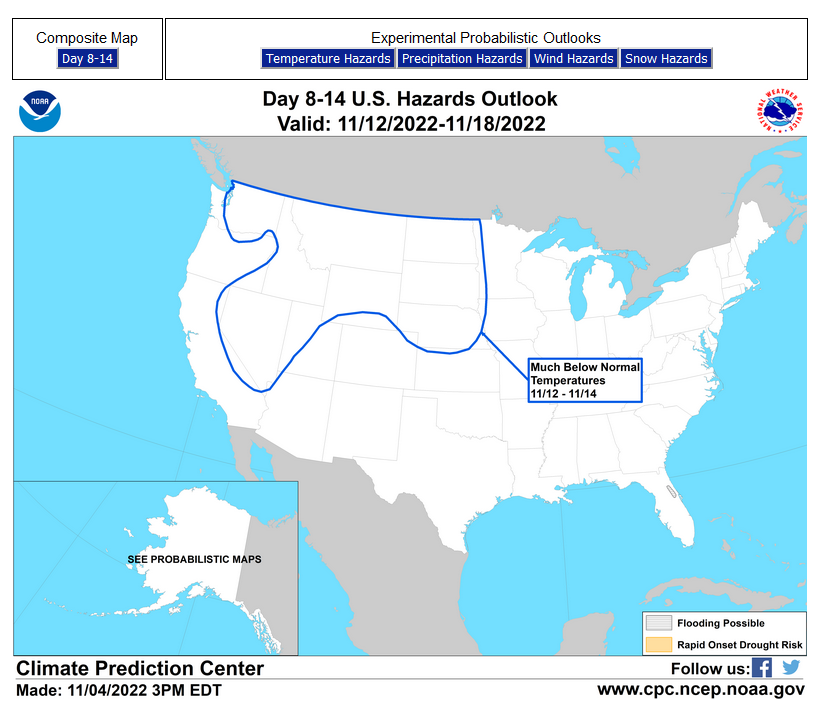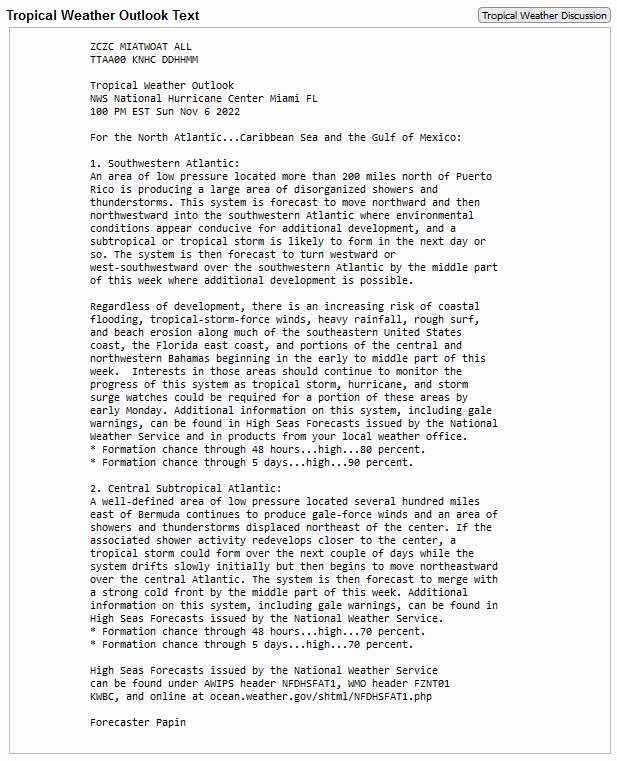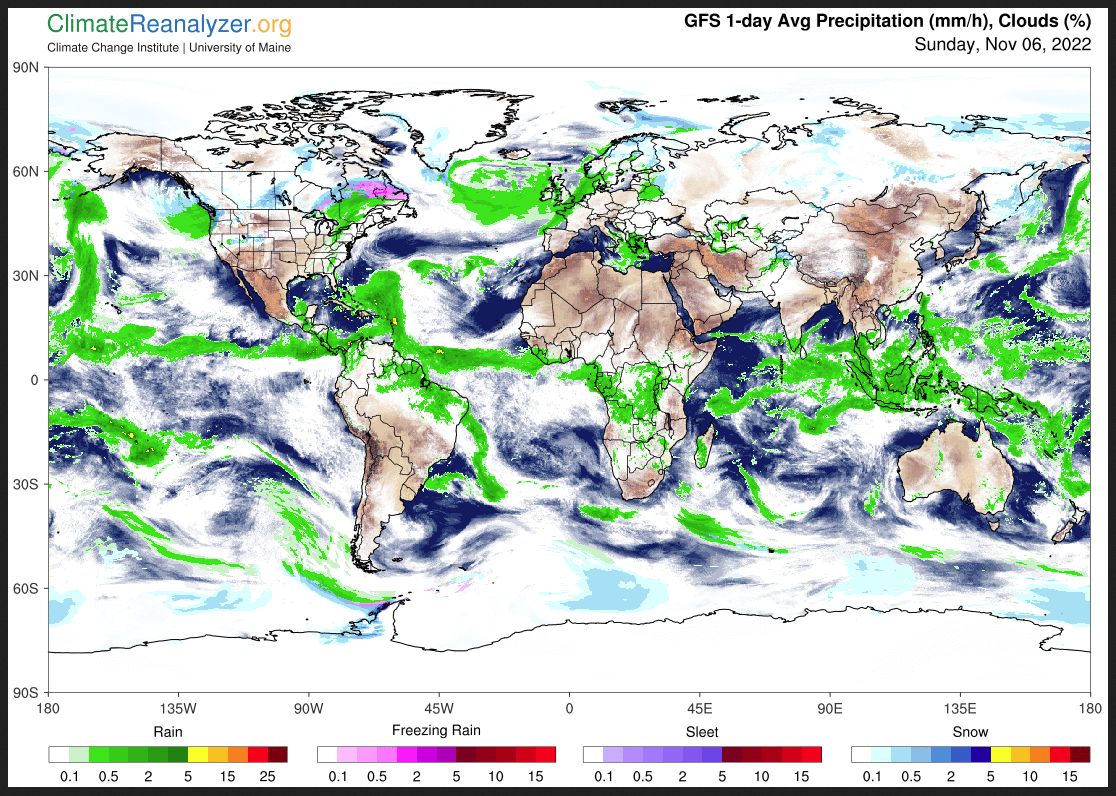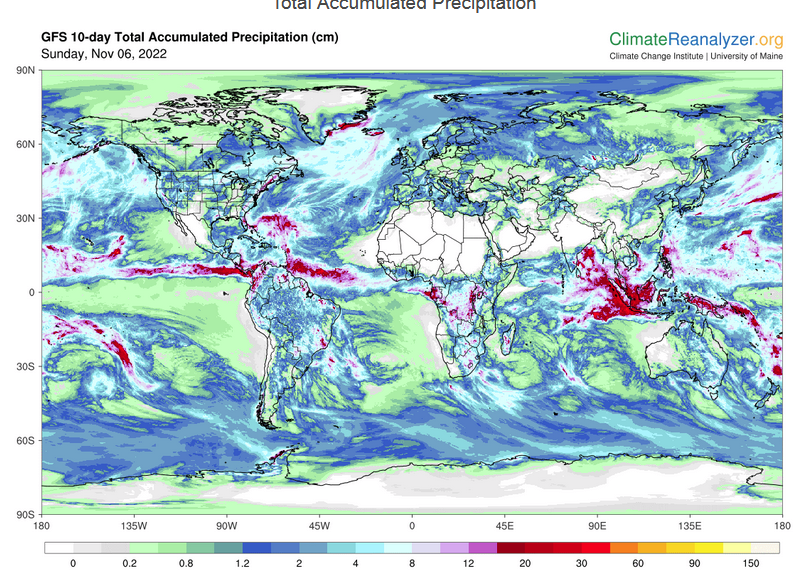Part II was updated at 6:05 p.m. EST on November 6 2022 to reflect the updated Sunday and Monday forecast. We will do another update later and then publish a new 48-hour report tonight.
Cold plus moisture means snow for the Northwest
NOAA updates many of its weather outlooks daily or even more frequently and in many cases issues a discussion with those outlooks. We provide a daily report which focuses on the shorter-term predictions but also has links to all the partial-month outlooks. Because WordPress does not provide the ability to have these maps automatically updated, our daily report shows some of the maps which we update each evening plus the links to the other important weather forecast maps.
Once a week we show many of the actual forecast maps not just provide the links to these maps. This makes it easier for the reader. Our report provides a separate forecast for Days1-5, Days 6 -10, Days 8 – 14, and weeks 3 and 4. This provides information that is useful to readers in terms of planning their activities for the next 28 days.
The week 3-4 outlook is only updated by NOAA’s Climate Prediction Service once a week on Friday. Thus, when we publish on Friday night, it provides a 28-day view of the future. What is important is that this is a longer-term view than one that is typically available in the media and online.
The key dynamic is the High Pressure over Alaska which brings cold air into the U.S. Northwest. Combined with the ongoing atmospheric river we end up with a wet and snowy Northwest. The intensity and extent of this pattern vary through the month as does the level of confidence in the strength of the pattern. Drought intensifies in other parts of the U.S.
We also include In Part II of the article the other information from the daily 48-hour forecast article. Importantly, this time of the year, it includes updates on tropical events. In both Parts I and II we also include some worldwide forecasts.
It is important to recognize that the forecasts do not always work out as predicted. But in the article, there are links to obtain updated forecasts If you read this article a few days or more after it is published. And there will be a totally updated version next Friday.

What NOAA is predicting for the next 28 days. (One may want to refer to the Monthly Outlook provided by NOAA which we reported on HERE.) Our Friday article provides more detail and shows how the monthly outlook changes as weather patterns evolve.
We will start with the short-term – It is up to date as of today. If you look at this article after today you can click the links to update (plus you will end up with a lot of additional information)
| Temperature (Maximum or Minimum Anomaly) for the next five days | Precipitation (Five days of cumulative precipitation) |
| https://www.wpc.ncep.noaa.gov/m edr/me dr_mean.shtml | https://www.wpc.ncep.noaa.gov/qpf/day1-7.shtml |
| The lows are above normal almost everywhere but not in the Northwest. There are three bands of precipitation. |
Now we look at “Outlook” maps for three time periods. Days 6 – 10, Days 8 – 14, and Weeks 3 and 4. An outlook differs from a forecast based on how NOAA uses these terms in that an “outlook” presents information as deviation from normal and the likelihood of these deviations.
I have provided the maps so you do not need to click to get them. But they do not update daily. But you can get the current images simply by clicking on the links provided. Then hit the return arrow at the upper left of your screen to return to the article. There is no need to do that right away since what is published today is up to date. The Week 3 – 4 Outlook only updates on Fridays.
Below are the links to obtain updates and additional information.
| West/ East divide for both temperature and Precipitation. The Northwest cool anomaly is extreme. |
| Temperature similar to Days 6 – 10 but the cool anomaly moderates. Precipitation is scarce almost everywhere. |
Prognostic Discussion for Week 3-4 Temperature and Experimental Precipitation Outlooks
NWS Climate Prediction Center College Park MD. 300PM EST Fri Nov 04 2022
Week 3-4 Forecast Discussion Valid Sat Nov 19 2022-Fri Dec 02 2022
La Niña conditions persist across the tropical Pacific and remain the dominant influence on anomalous convection throughout the global tropics. The Madden-Julian Oscillation (MJO) continues to be relatively weak with multiple atmospheric Kelvin waves evident in the diagnostic tools since September. Currently, a Kelvin wave is crossing the east-central Pacific. Since the GEFS and ECMWF models maintain a weak MJO through late November, the MJO was not used as a predictor. Along with La Niña composites, the Week 3-4 temperature and precipitation outlooks are based on dynamical model forecasts from the CFS, ECMWF, GEFS,JMA, and SubX multi-model ensemble (MME) of experimental and operational ensemble prediction systems.
The GEFS and especially the ECMWF ensemble mean depict a highly amplified 500-hPa ridge over Alaska during mid-November which leads to anomalously cold temperatures across the western two-thirds of the CONUS during week-2. The major challenge in the week 3-4 temperature outlook is whether this anomalous ridging over Alaska and its effects on temperatures downstream across the western and north-central CONUS persist into the latter half of November. The CFS, GEFS, and JMA models indicate that the 500-hPa ridge axis retrogrades westward to the Aleutians and north-central Pacific during week-3. Although the ECMWF model also shifts the 500-hPa ridge axis slightly to the west over Alaska, it maintains a full-latitude ridge, which would translate to a much colder outcome for the West and northern Great Plains. Given the longwave pattern heading into week-3, large probabilities of below normal temperatures forecast by the ECMWF model, and a weak signal from the GEFS, below normal temperatures are slightly favored for much of the West. Also, the predicted large increase in snow coverage across the West during early November was considered. The largest probabilities (above 55 percent) for below-normal temperatures are forecast across the northern high Plains, supported by good agreement between the ECMWF and GEFS. Positive 500-hPa height anomalies support elevated probabilities of above-normal temperatures across the south-central and eastern CONUS. Probabilities for above-normal temperatures were reduced slightly across the central to southern Great Plains due to concern of additional outbreaks of anomalous cold later in November.
The amplified trough near the West Coast supports increased probabilities for above normal precipitation across the Pacific Northwest, northern Rockies, and the Great Basin. The favored wet area extends south to include much of California, given the amplitude of the trough among all the dynamical models. The largest probabilities (above 60 percent), centered over Oregon, is consistent with the ECMWF model and La Niña composites. Positive 500-hPa height anomalies and the dynamical model consensus generally result in elevated probabilities for below-normal precipitation across the southern tier of the CONUS and along the East Coast. La Niña composites and excellent model agreement raise probabilities for below-normal precipitation across the Southeast. Equal chances (EC) for below or above-normal precipitation is forecast for much of the southern Great Plains, given a weak signal in the ECMWF model and considerations of the amplified 500-hPa trough upstream. EC is also necessary for the north-central CONUS given either weak or conflicting signals among the precipitation tools.
The dynamical models depict anomalous ridging over the Aleutians, Bering Sea, and western Mainland Alaska with a downstream trough axis near or over eastern Mainland Alaska. This longwave pattern favors below normal temperatures across the Alaska Panhandle with elevated probabilities for above normal temperatures throughout western Mainland Alaska and the Aleutians. Consistent with the colder-than-normal temperatures and La Niña, below normal precipitation is most likely across parts of southeastern Alaska. Across western Mainland Alaska, the 500-hPa circulation pattern, forecast by the ECMWF model, would lead to enhanced onshore flow which slightly elevates probabilities for above-normal precipitation.
The SubX MME depicts large probabilities (above 80 percent) for above-normal temperatures throughout Hawaii and positive SST anomalies also support a strong likelihood for above-normal temperatures. The Week 3-4 precipitation outlook leans wet, based on the SubX MME and is also consistent with the ongoing La Niña.
| It is important to note that the Week 3 -4 Outlook is prepared by a different team than the 6 -10 and 8 – 14 day Outlooks as well as the update of the monthly outlook. |
Now switching over to Part II of this article which is our regular 48-Hr Forecast which also includes links for tropical updates and in some cases the NHC maps for storms that are near-term threats.
Here is what we are paying attention to today and the next 48 hours from this afternoon’s NWS Forecast. This is the forecast for Sunday, November 6, 2022
Short Range Forecast Discussion NWS Weather Prediction Center College Park MD 128 PM EST Sun Nov 06 2022 Valid 00Z Mon Nov 07 2022 - 00Z Wed Nov 09 2022 ...Moderate to Heavy coastal rain/mountain snow expected across the western mountains... ...Above normal temperatures continue in the East through Monday; cooler air expands across the West... A deep upper-level low will drive the hazardous weather in the West while an upper ridge amplifies as it shifts from the central U.S. into the East. A series of low pressure systems will glide down the West coast as they spread anomalous Pacific moisture over the region. Moderate to heavy rainfall is likely along the coast and in lower lying areas in the interior of the West. The rainfall may pose a particular threat to parts of southern California on Tuesday, where a slight risk of flash flooding is in effect. Scattered to isolated thunderstorms are also possible over parts of California over the next couple of days. Moderate to heavy snowfall already underway in the Cascades and Northern Rockies is expected to spread into the Sierra and Central Rockies tonight. Light to moderate snow may also impact portions of central/northern Montana. Between 2-4 feet of snow is likely to fall over the Sierra through Tuesday and 1-2 feet of snow possible in the Northern Plains with locally higher amounts possible during this period. Cold air will filter in across the West as the upper low and associated surface cold fronts swing through the region. High temperature anomalies ranging between 15-25 degrees below average are likely to be realized in the West through Tuesday with the greatest departures from normal occurring over over Montana and the Cascades/Rockies. An upper ridge will allow warm southerly air to flow into the eastern U.S. over the next day or so before a moderating trend brings seasonal fall temperatures back by midweek. A tightening pressure gradient, dry conditions and above normal temperatures will pose elevated fire weather concerns over portions of the Northern Plains/Upper Midwest through tomorrow. Some light thunderstorm activity may develop over parts of the ArkLaTex on Monday before the approaching western low pressure system focuses more rain and thunderstorms over the Upper Midwest by Tuesday evening.
(It is updated twice a day and these updates can be found here.
Current forecast of heavy precipitation (Updates can be found HERE)
Click HERE to update. HERE is some useful information about Atmospheric Rivers.
Maps that relate the forecast to geography can be found by clicking Here for Day 1 and Here for Day 2.
Here is a 60-hour animated forecast map that shows how the short-term forecast is expected to play out.
If it needs to be updated click here.
HAZARDS OUTLOOKS
Click here for the latest complete Day 3 -7 Hazards forecast which updates only on weekdays. Once a week probably Monday or Tuesday I will update the images. I provided the link for readers to get daily updates on weekdays. Use your own judgment to decide if you need to update these images.
Worldwide Tropical Forecast
(This graphic updates on Tuesdays) If it has not been updated, you can get the update by clicking here
Detailed Maps and Reports.
Below are four maps that summarize the situation for the Atlantic, Eastern, Central Pacific and Western Pacific. Additional information can be accessed by clicking HERE
First the Atlantic
Click to view the forecast map and have access to additional information https://www.nhc.noaa.gov/gtwo.php ?basin=atlc&fdays=5
Then Eastern Pacific
Click to view the forecast map and have access to additional information https://www.nhc.noaa .gov/gtwo.ph p?basin=epac&fdays=5
Then Central Pacific
Click to view the forecast map and have access to additional information https://www.nhc.noaa.gov/gtwo.php?basin=cpac&fdays=5
And the Western Pacific
Click to view the forecast map and have access to additional information https://www.metoc.navy.mil/jtwc/jtwc.html
Updates and additional information can be accessed by clicking HERE
World Forecast
Below is the current or short-term precipitation forecast which can be updated by clicking HERE Additional maps for different time frames and other aspects of weather in addition to precipitation can be obtained HERE.
Month to Date Information
Temperature month to date can be found at https://hprcc.unl.edu/products/maps/acis/MonthTDeptUS.png
Precipitation month to date can be found at https://hprcc.unl.edu/products/maps/acis/MonthPNormUS.png



